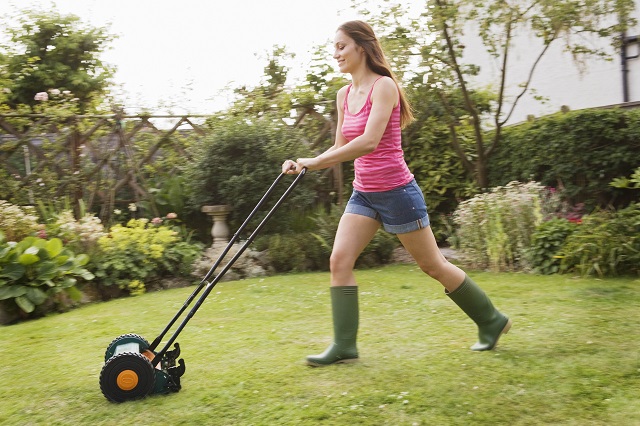
Having a healthy, beautiful lawn is important for your home’s curb appeal, and offers many other important benefits to homeowners. When you learn basic lawn care, you’re able to keep your grass healthy and prevent the growth of weeds.
Understanding how to care for your lawn, from mowing and cleanup to fertilization and landscaping, and it gives you a healthy, pest-free surface where your children and pets can safely play. Healthy grass is a natural filtration system that filters the air from dust and dirt, which in turns helps to contribute to a healthier home.
Bonus? It’ll make your home look welcoming and well-tended to, improving its curb appeal.
Fertilization
All plants need some fertilization to promote healthy growth—whether it’s organic or synthetic is your choice. When you fertilize your lawn properly, you’ll get dense grass that has a lively, bright green hue.
When applying fertilizer to your yard and garden, make sure it’s evenly spread throughout the area. You can do this by using a spreader machine to apply the fertilizer in an even, orderly pattern. Don’t have a spreader? You could rent one or hire a fertilizing service near you that will assess which kind of fertilizer and spread you need.
How to Apply Fertilizer:
- Make sure you water your lawn a day or two before applying the fertilizer.
- Let it thoroughly dry.
- Apply fertilizer using a spreader for even distribution.
- Water your lawn again to wash excess fertilizer off the grass blades and encourage it to seep into the soil below.
Another way to naturally fertilize your lawn is to let the grass clippings lie in place. This creates nitrogen naturally, which is an excellent form of fertilization for plants. Never over-apply fertilizer or else it can burn your grass. Instead, fertilize lightly twice per year.
Maintaining and Mowing Your Lawn
When it comes to mowing and lawn maintenance, there are a few simple rules you should follow to keep the grass looking healthy.
How to Mow a Lawn:
- Don’t cut your grass too short. Also called scalping, this could stunt future growth.
- Keep your lawnmower blades sharp. A sharp mower blade cuts evenly and extends the life of the machinery. Avoid mowing over large objects like rocks or branches because these can cause damage to your mower.
- Mow the lawn when the grass is dry since wet grass, and other wet organic matter, can clog your lawnmower.
- Mow in a different pattern every time to encourage the grass to grow strong and healthy.
- Use an edge trimmer to keep everything looking and nice and tight near curbs, driveways, and walkways.
Yard Cleanup
After you’ve fertilized and mowed your lawn, it’s time for some yard cleanup. Removing excess waste will have your yard looking trim and neat.
Use a good pair of gardening gloves to pick up stray branches and cut-down plants. You can place this organic matter in a compost pile which can be used later as a natural fertilizer for your flowers, trees, vegetable garden, and grass.
Create a mulch from grass clippings that will help to keep moisture in throughout the warmer months and reduce the need for watering. Prune back any overgrown plants. This process will promote healthy new growth and make your yard look more visually appealing.
Rinse down walkways using a rented pressure washer to clean off dirt and debris.
During the fall, use a leaf blower or rake to remove dead leaves so that your lawn still looks green and healthy, even when the weather turns cooler.
If you’d rather leave the cleanup to professionals, look for yard clean up services near you.
Landscaping
After you’ve fertilized, cut, and cleaned up your lawn, it’s time to focus on landscaping. Adding colorful flowers, shrubs, and unique trees can provide new life to a tired yard.
First, you’ll need to ask, which zone do I live in? Talk to local landscapers or professionals at your local garden center to choose plants that will thrive in your region. They’ll also instruct you on how to ensure that it grows healthily over time.
Create a natural edge around your home by planting flowering shrubs. This will add color and a natural border that defines the space. Mix and match a variety of plants to give your lawn and garden tons of visual interest.
For flowers or vegetables, you can make a container garden by planting various species in different pots and placing them throughout the space. Container gardens are easy to maintain, and you can move them anywhere as needed.
Use mulch in your garden bed to add color, style, and give your plants added protection. Mulch comes in a variety of materials like wood or rubber, and you can choose from a selection of appealing colors.
 Raising Chickens at Home
Raising Chickens at Home  Spring Garden Flower Tips and Suggestions
Spring Garden Flower Tips and Suggestions  Plan Ahead for a Better Yard
Plan Ahead for a Better Yard  Dry Well Cleaning & Maintenance Tips
Dry Well Cleaning & Maintenance Tips  Backyard Tree Identification Guide
Backyard Tree Identification Guide 

Since I will need service Bi-Monthly, can i arrange to pay by the monthly bases?